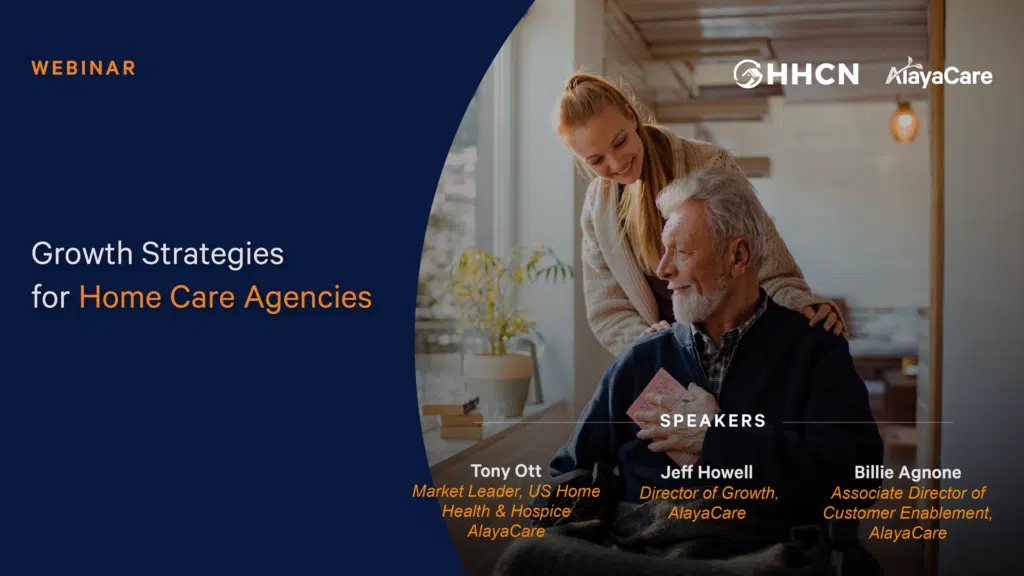Blog
Home-based care marketing: How you can get started with a client referral program
![BlogTreatment-7a (1) The Faces of Our Workforce: Strategies to Recruit and Retain Caregivers [Webinar Recap]](https://alayacare.com/wp-content/uploads/2023/05/BlogTreatment-7a-1-1024x543.png)
Referrals can become a large part of your client marketing efforts, and here are some helpful tips to get you started.
6 out of the top 20 marketing sources for home care and home health clients came from healthcare professional referrals. Opportunities to connect with referral sources and networking opportunities are invaluable to your agency’s success.
So, starting a client referral program can be a highly effective method for attracting new clients. Referral programs are built on the trust and satisfaction of existing clients, which means they can often lead to higher-quality leads. When your clients are happy with the services you provide, they are more likely to refer friends, family, or acquaintances who might need similar services. This word-of-mouth marketing not only helps expand your existing client- base but also builds your brand reputation in the community.
Moreover, a client referral program can be a cost-effective marketing strategy for home-based care agencies. Compared to traditional advertising or marketing campaigns, referral programs require less financial investment. Instead, they leverage the relationships you’ve already established with your clients. Offering incentives, such as discounts on future services or small gifts, can further encourage clients to participate in the program. Overall, a well-designed client referral program can significantly boost client acquisition and contribute to the growth of the agency.
Building and maintaining a successful home-based care referral source network is absolutely essential if you want to increase the number of referrals coming into your home care and home health business. Check out our blog to learn more: 5 steps to building, strengthening, and maintaining a home care referral network
How to start your organization’s client referral program

1. Make a list of referral sources in your area
There are probably many places close to you that could send a referral your way. Start by making a list of each potential business that could refer a patient or resident to you.
You could even segment this list by target referral sources in each part of the senior living and senior care spectrum. For example, you could list your preferred home care provider or an award-winning assisted living facility in your area.
You can also think outside the box when it comes to potential referral sources. Think outside of healthcare, too. One example could be a local house cleaning business or a pharmacy.
You could also sort referral sources into categories, such as:
- Government agencies
- Other healthcare professionals
- Senior and geriatric advisors
- Miscellaneous other sources
Are there places outside of the home that you can think of as potential partnership or client referral opportunities? Some home care agencies offered temperature screening and COVID-19 screening stations for larger businesses.
2. Create a plan for client referral source outreach and personalize it based on each provider’s needs, client population, etc.
Just with any marketing strategy, you need a plan. Here are some pieces of information that you should include:
- What do you offer
- Why you’re different
- How you’ll care for their clients, residents, etc.
- Include an email and call cadence to make sure that you follow up on time
When sending an email or conducting any outreach, personalize the messaging for each new business, that you’re reaching out to.
For example, you could be saying:
“We’re the best home care business in the Milwaukee area, refer your clients to us.”
Adding personalized touches makes all the difference:
“As a home care business, we recognize the need for your clients to transition home safely after a brief stay in rehab to ensure continuity of care and adherence to treatment plans.”
Just as you have a plan to touch base with your clients regularly, like Friday check-up calls, for example, you need to have a similar cadence for your referral sources.
The social workers and nurses you interact with may get busy, and they may also interact with your competitors. This highlights the need for you and your team to keep your home care agency at the top of your referral partners’ minds.
They’re listening to elevator pitches and statistics about home care from your competitors; you need to highlight your differentiators, satisfaction survey results, and the outcomes of your clients. Instead of explaining what home care is, for example, explain what it does for your clients.
4. Make each client touchpoint intentional and with a purpose
When executing your first referral program strategy plan, make sure that each call, email, and visit has a purpose.
For example:
- Does the community have any clients that they’re worried about discharging back home? What are their concerns?
- Meet with a variety of staff members instead of just one so that you can develop a well-rounded view of the business.
- Do what it takes to become familiar with their unique challenges and pain points so that you can customize your language to theirs.
Your referral marketing plan could include a touchpoint every 30 days, but what you do at that 30-day mark impacts how this other referral partner perceives your agency. How are you going to start the conversation?
Set the tone of the conversation around them. Do they have any fall concerns for their clients? Do they have any clients whose loved ones live too far away to visit?
Think about which approach would be best for your agency and your prospective referral partner, and find mutually beneficial topics that you can both speak on. This could lead to community panel discussions, joint presentations, and cross-company in-services.
5. Bring evidence and tangible successes that you’ve brought to clients and referral sources
Client surveys are a great tool to demonstrate your success and commitment to quality client care. Your referral sources want the best for their clients, residents, and patients, and when they see that you have evidence to back up your claims, they will have no problems referring people to you.
From reviews to specific feedback, and other testimonials you may receive, these demonstrate a track record of your success. Use the phrasing of these reviews and alter them to speak better to your referral sources and their pain points.
For example, if you measure your fall rates or hospital readmission rates, these would be valuable for a hospital to see. They want to know that when their clients need to be discharged with home care, they’ll be in the safe, capable hands of trained caregivers.
In order to better communicate with hospitals, you can adapt your language to include more accurate or appropriate terminology. For example, with falls, talk about whether they were anticipated (expected) or unanticipated (unexpected) falls, and whether they were witnessed or unwitnessed. Doing research into each client referral source and learning how they talk about certain things can help you stand out from the crowd.
With the evidence and dedication you put into creating meaningful outcomes for your clients, referral sources will be well-educated on the services you provide and the value you bring to any clients they refer to you.
6. Getting client referrals is easy, but it requires a lot of work beforehand
There are many details and backend work that go into making a referral source into a meaningful referral partner. There’s no exact number on how long or how many touchpoints you need to make in order to receive a referral, but it could take some time.
You may be in communicating with a referral source for six months or a year before they feel confident enough in you to send a referral your way.
Gary Vaynerchuk, the chairman of Vayner X, said, “Saying hello doesn’t have an ROI. It’s about building relationships.” Think about your agency’s greeting when meeting with a referral source, or when sending an email. How is your home care agency saying hello?
Conclusion: Boost your client referrals with a smart referral program
In conclusion, building a referral program within a home-based care organization is not just a smart business strategy, but a significant way to foster growth and deepen relationships with clients. It leverages the power of word-of-mouth marketing, turning satisfied clients into brand ambassadors who can bring in new clients. This cost-effective method not only helps to expand the client base but also strengthens the agency’s reputation in the community. However, it’s crucial to remember that the foundation of a successful referral program lies in providing exceptional care services. After all, only happy and satisfied clients will be motivated to refer others. So, invest in your caregivers, deliver top-notch service, and watch as your referral program fuels your agency’s growth.
Want to learn more about client referrals and other marketing tips for home-based care?
Watch our on-demand webinar; we discuss three key areas to help grow your business: marketing, referral management, and reputation management.
What you’ll learn:
- Techniques to build and maintain trust with clients and their families
- Ideas to differentiate your home-based care business to stand out from the crowd
- How to determine your best referral sources and maximize those sources
- How to ensure referrals across multiple business lines
This blog was recently edited and updated
This blog was written by Jennifer Lagemann of Home Care Pulse
Jennifer comes from a senior care background, beginning as a family caregiver and working her way up into various home care administrative roles, ranging from scheduling coordination, to care management and intake management. She has worked with over five agencies, including major franchises. She has a passion for writing and wants to keep others informed – especially when it comes to searching for senior care options.


